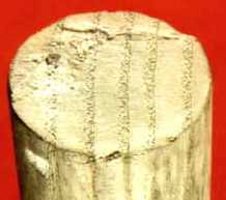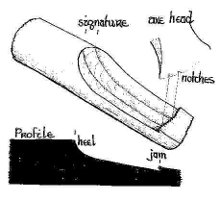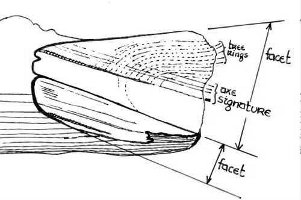Technique
Wood can be
preserved for long periods of time under anoxic, waterlogged
conditions. Whilst the absence of oxygen reduces the rate of
decomposition, wood is always
modified in the burial environment. Prior to the oxygen being used up,
fungal and microbial action results in the loss of cellulose, an
important structural polymer in the wood. As a result the wood is very
much
weakened -under extreme conditions, only a lignin skeleton is left -
and whilst this
may retain all of the detail of the original wooden artefact, its
strength is less
than 1% of that of modern wood.
After excavation the wood is exposed to air again, and the decay
process can re-start.
Most conservation processes rely on drying the wood - so the absence of
water now becomes the limiting factor for decay. In its weakened state,
however,
wood shrinks excessively, and tends to break up (see Figure 2 on the
right).
Figure 2. The effect of drying - originally
the same size as the piece of wood to the left, drying has resulted in
structural
collapse and partial fragmentation. (Medieval elm (ulmus sp.))
|

|
The
conservation problem is to dry the wood without it being destroyed by
this process.
Supercritical drying, a new technique developed at St Andrews avoids
the shrinkage
problem by replacing the liquid in the wood with a high-density gas or
supercritical fluid. The supercritical fluid can be removed from the
wood by
decompression without forming a liquid phase. As shrinkage is due to
surface tension
forces at a liquid surface, supercritical drying does not damage the
artefact.
The supercritical fluid we use is carbon dioxide, which is cheap and
safe, but will not
mix with water. In consequence the water in the artefact must first be
replaced
with an organic solvent - methanol. At high pressure the carbon
dioxide's
density is similar to that of common liquids, and it readily dissolves
the methanol.
Below are some of the samples conserved by supercritical drying, which
demonstrate some
of the advantages of this technique.
 |

|
Figure 3. A Mesolithic 'lump' dating from
8000 years
BCE
|
Figure 4. Structural
timber from the Dartmouth (1690), eroded by
gribble, but still sound.
|
The
technique of supercritical drying, allows wood in any condition to be
dried without modifying the methodology. So that heavily degraded
material, with no inter-fibre adhesion, (Mesolithic timber above), and
sound timber, such as that from the Dartmouth
(see examples), both responded well. Other methods rely on replacing
water within the wood structure with a polymer, which cannot normally
be introduced into cork, and some other dense woods, which remain
impermeable. Further, polymers and other foreign material accelerate
the corrosion of metal, by dissolving the protective surface oxide, or
simply by keeping it wet.

|

|
Figure 5. A
cork bung from a 'dog buoy' (an inflated dog skin, commonly used to
lift fishing gear in the past). Successfully conserved by supercritical
drying after attempts at freeze drying had failed.
|
Figure 6. Compass
base from the Swan.
Composed of a heavily degraded turned wood platen, with a lead righting
weight. A copper pin projects from the centre of the lead weight, this
acted as the bearing on which the compass card would have turned.
|
Under some circumstances supercritical drying offers advantages over
other methods. Firstly in helping to stabilise the material, for
example, bone. In this instance the carbon dioxide used in the
technique converts any organic calcium salts into calcium carbonate. If
left in place, these salts can result in the formation of 'Bynes
disease', a white efflorescence which can result in loss of surface
detail. Secondly, the absence of any foreign material means that the
internal structure of the wood is not obscured.

|

|
Figure 7. Human
vertebra from the Swan, after conservation by supercritical drying.
|
Figure 8. Cross
section of an ash spear shaft (Fraxinus excelsior) from Nydam Mose,
Denmark.
|
Tool
Marks
As the true potential of wetland archaeology is becoming recognised
there is
increasing interest in evaluating the tool marks left by the makers
(Figure 9, Figure 10). If
two timbers bear the same tool marks, then they are likely to have been
part of the same construction. This can be a very useful aid to
understanding crannog construction. The sites of these lake dwellings
have normally been re-used many times over periods of several thousand
years. This leaves a confusing jumble of timber on the lake bottom, and
any technique, which helps to relate this material, is potentially
helpful. Tool mark analysis has not yet fulfilled all of its promise,
but is increasingly finding utility as a check on dendro-chronology and
other analytical techniques. |

Figure 9. Marks left by notches of an axe
head
|
 |
Figure 10. Sketch
of the house post from above, showing two facets (each produced by a
single axe blow), and the signature, an array of parallel marks in the
wood produced by nicks and burrs on the axe blade. The tree rings cut
through by the axe are shown by the dotted lines.
|
Below, two early worked timbers showing tool marks, conserved by
supercritical drying.
 |
 |
Figure
11. Tool
marked
house post, photo in strong cross illumination
|
Figure
12. Early
bronze age coppice wedge from the Seaton 3 excavation.
|
Ruben Duque 2011.
All rights reserved
|